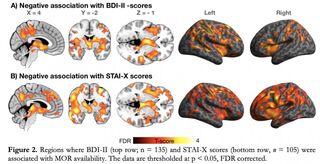Anxiety
Beyond Runner's High: The Upside of More Endorphin Receptors
Endogenous mu-opioid receptors may play a key role in depression and anxiety.
Posted June 17, 2020
Endorphins became a household word in the late 1970s when Candace Pert and colleagues (Snyder & Simantov, 1977) at Johns Hopkins University School of Medicine made front-page news by identifying opiate receptor binding sites for endorphins in the brain. Endorphin is a combination of the words "endogenous" (originating from within an organism) and "morphine." Colloquially, endorphins are synonymously referred to as "the body's own morphine" or "self-made morphine."
Many people associate the release of endorphins during aerobic exercise with runner's high. Throughout The Athlete's Way: Sweat and the Biology of Bliss (2007), I refer to the binding of endorphins to mu-opioid receptors as one of the key reasons that cardiorespiratory exercise can have an analgesic effect: "Gram for gram, endorphin is three times more powerful than morphine. The more intensely you work out, the more this natural painkiller is released into the bloodstream."
The notion that high-intensity interval training (HIIT) releases endorphins was corroborated 10 years later in a study (Saanijoki et al., 2017) from the Turku PET Centre at the University of Turku in Finland. (See "One Surefire Way to Release Endorphins Into Your Brain.")

Now, researchers from the Turku PET Centre have published a new study (Nummenmaa et al., 2020) showing that the brain's mu-opioid system appears to be associated with mood changes related to depression and anxiety. "Major depressive disorder is associated with lowered mood, anxiety, anhedonia, sleep problems, and cognitive impairments. Many of these functions are regulated by the mu-opioid receptor (MOR) system," the authors explain. These findings were published May 30 in the journal Neuropsychopharmacology.
"We found that the more depressive and anxious symptoms the subjects had, the less opioid receptors there were in their brain. These receptors function like small 'docks' that are influenced by both the brain's own opioids [e.g., endorphins] as well as opiates. These type of opioid-mediated mood changes can be an important mechanism in the central nervous system," first author Lauri Nummenmaa of the University of Turku said in a June 16 news release. Nummenmaa is the lead investigator at Turku PET Centre's Human Emotion Systems Laboratory.
The most recent neuroimaging study (2020) from the Turku PET centre suggests that it may be possible to predict someone's predisposition for generalized anxiety disorders or clinical depression before symptoms appear based on higher or lower availability of endogenous mu-opioid receptors.
For this large-scale, cross-sectional study, Nummenmaa et al. pooled data from 135 volunteer study participants who each had the availability of endogenous mu-opioid receptors in different brain regions measured with positron emission tomography (PET). Symptoms of depression and anxiety were assessed using various questionnaires.
"Both anxiety and depression scores in the subclinical range were negatively associated with [endogenous mu-opioid receptor] availability in cortical and subcortical areas, notably in amygdala, hippocampus, ventral striatum, and orbitofrontal and cingulate cortices," the authors write in the paper's abstract. "We conclude that dysregulated [mu-opioid receptor] availability is involved in altered mood and pathophysiology of depression and anxiety disorders."
Rethinking the Universality of Runner's High
The latest research (2020) showing that lowered availability of mu-opioid receptors might be a marker for depression and anxiety triggered an "Aha!" moment for me relating to the elusiveness of runner's high for some people. Anecdotally, it has come to my attention in recent years that not everyone experiences a so-called "runner's high" during or after vigorous exercise.
In the early 2000s, I wrote: "The same anandamide, endorphin, and dopamine that flows through you flows through me, too. Anybody can experience the bliss of runner's high if they break a sweat doing cardio." Knowing what we know now, this decades-old hypothesis seems short-sighted and not 100% accurate. I realize now that when I first started writing about "sweat and the biology of bliss," I mistakenly assumed that aerobic exercise had a universal ability to make everyone feel equally good. In a way that may have seemed too "Kumbaya" to some, I presented runner's high and the joy of physical activity as something egalitarian that was universally accessible to us all.
Over the years, countless readers have emphatically told me that exercise does not make them feel happy or euphoric. And no matter how hard they push themselves during cardio workouts, many say they've never experienced runner's high. Why is this? In light of the latest brain imaging research, it seems plausible that people with a higher availability of mu-opioid receptors may be more likely to experience runner's high. On the flip side, one could speculate that people who don't get an endorphin rush from exercise may have fewer endogenous mu-opioid receptors at their disposal.
A growing body of evidence suggests that even if exercise triggers an increase of endogenous substances such as endocannabinoids or beta-endorphin, if someone lacks the availability of cannabinoid (CB1) or mu-opioid receptors, these endogenous substances are left without docking stations, which renders them useless. (See "Can Your Body's Cannabinoids Extinguish Traumatic Memories?")
The million-dollar question remains: Is it possible to increase the availability of endogenous mu-opioid receptors to offset someone's risk of depression and anxiety while simultaneously boosting his or her odds of experiencing runner's high? Stay tuned for future research that will advance our understanding of these molecular mechanisms and may lead to effective psychopharmacology-based interventions.
References
Lauri Nummenmaa, Tomi Karjalainen, Janne Isojärvi, Tatu Kantonen, Jouni Tuisku, Valtteri Kaasinen, Juho Joutsa, Pirjo Nuutila, Kari Kalliokoski, Jussi Hirvonen, Jarmo Hietala, Juha Rinne. "Lowered Endogenous Mu-Opioid Receptor Availability in Subclinical Depression and Anxiety." Neuropsychopharmacology (First published: May 30, 2020) DOI: 10.1038/s41386-020-0725-9
Tiina Saanijoki, Lauri Tuominen, Jetro J. Tuulari, Lauri Nummenmaa, Eveliina Arponen, Kari Kalliokoski, Jussi Hirvonen. "Opioid Release After High-Intensity Interval Training in Healthy Human Subjects." Neuropsychopharmacology (First published: July 19, 2017) DOI: 10.1038/npp.2017.148




